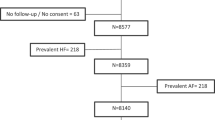Summary
The aim of the present study was to assess the effects of carvedilol therapy in addition to conventional heart failure therapy on heart rate variability (HRV) and on left ventricular function in 14 patients with mild to moderate heart failure due to idiopathic dilated cardiomyopathy (IDC). After a 3- to 4-week titration period, carvedilol was titrated up to 50mg daily, or the highest dose tolerated (at least 25mg daily). Maintenance treatment was then continued for 8 weeks. Digital 24-hour Holter recordings were obtained at baseline and after 8 weeks of carvedilol therapy. HRV for the entire 24-hour period was computed in the time domain using the Oxford Medilog Excel 2 analysis system. Measures of HRV included the mean of all coupling intervals between normal beats (RRm), the standard deviation of all normal RR intervals (SDNN), the square root of the mean of the squared differences between adjacent normal RR intervals (rMSSD), and the proportion of adjacent normal RR intervals differing >50ms (pNN50).
Additional treatment with carvedilol induced a significant increase in HRV: SDNN increased from 77±21ms to 110±22ms (p=0.001), rMSSD from 19±7ms to 26±7ms (p=0.02), and mean pNN50-value increased from 1.7±1.3% to 5.5±4.5% (p<0.01) under therapy with carvedilol. Mean heart rate on carvedilol calculated over 24 hours was 13 beats less than at baseline (75 bpm versus 88 bpm, p<0.01). After 2 months of additional treatment with carvedilol, both hemodynamic and clinical parameters improved: left ventricular ejection fraction increased from 24±7% to 30±10% (p<0.05), and New York Heart Association class decreased from 2.5±0.8 to 1.8±0.7 (p<0.05).
In summary, eight weeks of additional carvedilol therapy induced a significant increase in HRV parameters related to parasympathetic activity in patients with IDC. Whether increased vagal tone may contribute to the protective effect of carvedilol has to be evaluated by further studies.
Zusammenfassung
In der vorliegenden prospektiven Studie wurde 14 Patienten mit dilatativer Kardiomyopathie (DCM) zusätzlich zu einer konventionellen Basistherapie bestehend aus Digitalis, Diuretika und ACE-Hemmern Carvedilol einschleichend bis zu einer maximalen Dosierung von 25–50mg/Tag verabreicht. Zu Beginn und nach 8 Wochen Therapie mit Carvedilol wurden aus digitalen 24-h-Langkeit-EKG-Registrierungen mittels des Oxford™ Medilog Excel 2 Analysesystems folgende Zeitbereichsparameter der Herzfrequenzvariabilität (HRV) bestimmt: RRm=Mittelwert aller normalen Kopplungsintervalle (NN), SDNN=Standardabweichung aller NNs, rMSSD=Quadratwurzel des quadratischen Mittelwertes der Differenzen aufeinanderfolgender NNs und pNN50=Anteil aller aufeinanderfolgenden NNs, die sich mehr als 50ms unterscheiden. Zusätzlich wurden vor und unter der Carvediloltherapie echokardiographische Untersuchungen durchgeführt sowie ein klinischer Status der Studienpatienten erhoben.
Unter der additiven Gabe von Carvedilol besserten sich alle Zeitbereichsparameter der HRV signifikant: SDNN stieg unter Carvedilol von 77±21 auf 110±22ms (p=0,0001), rMSSD von 19±7 auf 26±7ms (p=0,02) und der mittlere pNN50-Wert von initial 1,7±1,3 auf 5,5±4,5% (p<0,01) an. Die über 24h gemittelte Herzfrequenz sank um 13 Schläge/min von zu Beginn 88±10 Schläge/min auf 75±10 Schläge/min (p<0,01). Die linksventrikuläre Auswurffraktion stieg von initial 24±7% auf 30±10% (p<0,05) unter Carvedilol an. Die mittlere NYHA-Klasse besserte sich unter Carvedilol von 2,5±0,8 auf 1,8±0,7 (p<0,05).
Zusammenfassend verbesserte die additive Therapie mit Carvedilol sowohl die Herzfrequenzvariabilität als auch echokardiographische und klinische Parameter bei Patienten mit dilatativer Kardiomyopathie.
Similar content being viewed by others
Author information
Authors and Affiliations
Additional information
Eingegangen: 14. März 1999, Akzeptiert: 28. April 1999
Rights and permissions
About this article
Cite this article
Hoffmann, J., Grimm, W., Menz, V. et al. Einfluß von Carvedilol auf die Herzfrequenzvariabilität bei Patienten mit dilatativer Kardiomyopathie. Z Kardiol 88, 653–660 (1999). https://doi.org/10.1007/s003920050341
Issue Date:
DOI: https://doi.org/10.1007/s003920050341




